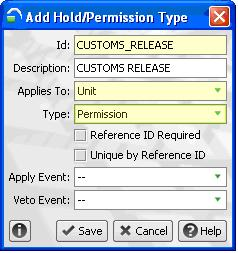
N4 supports EDIFACT standard CUSRES message, release D & version 96B. As per EDIFACT standard, CUSRES has various message function codes in BGM segment. But N4 supports only Original & Update function codes.
This specification provides the definition of the Customs response message (CUSRES) to be used in Electronic Data Interchange (EDI) between Customs department & a terminal in marine domain.
This Customs Response Message (CUSRES) permits the transfer of data from a customs administration:
To acknowledge the receipt of the message
To indicate whether the information received is correct or if there are errors (i.e. accepted without errors, accepted with errors, rejected, etc.)
To inform the sender of the status of the customs declaration (i.e. goods released, goods for examination, documents required, etc.)
To transmit additional information as agreed between parties (i.e. tax information, quantity information, etc.)
To respond to batched messages (i.e. CUSDEC, CUSCAR, CUSREP, CUSEXP).
In a terminal, CUSRES EDI is received from Customs Department. This can result following effects in N4:
Place a Hold(s) for container(s) & Bill of Lading
Release Hold(s) for container(s) & Bill of Lading
Grant Permission(s) for container(s) & Bill of Lading
Revoke Permission(s) for container(s) & Bill of Lading
A CUSRES EDI may contain:
List of containers
List of Holds/Permissions
Vessel visit information
CUSRES D 96B Inbound Supported Segments
Following table illustrates the segments of EDIFACT standard CUSRES D 96B message & scope of each segment in N4.
|
S. No. # |
Segment ID |
Supported Qualifier |
Description |
Supported in N4? |
|---|---|---|---|---|
|
1 |
BGM |
|
Beginning of message |
Supported |
|
2 |
DTM |
|
Date/time/period |
Not Supported |
|
3 |
FTX |
DIN |
Free text |
Supported |
|
4 |
TDT |
|
Details of transport |
Supported |
|
5 |
LOC |
|
Place/location identification |
Not Supported |
|
6 |
GIS |
|
General indicator |
Supported |
|
7 |
EQD |
|
Equipment details |
Not Supported |
|
8 |
NAD |
|
Name and address |
Not Supported |
|
9 |
CTA |
|
Contact information |
Not Supported |
|
10 |
COM |
|
Communication contact |
Not Supported |
|
11 |
RFF |
|
Reference |
Not Supported |
|
12 |
DTM |
|
Date/time/period |
Not Supported |
|
13 |
LOC |
|
Place/location identification |
Not Supported |
|
14 |
ERP |
|
Error point details |
Not Supported |
|
15 |
RFF |
|
Reference |
Not Supported |
|
16 |
ERC |
|
Application error information |
Not Supported |
|
17 |
FTX |
|
Free text |
Not Supported |
|
18 |
TAX |
|
Duty/tax/fee details |
Not Supported |
|
19 |
MOA |
|
Monetary amount |
Not Supported |
|
20 |
GIS |
|
General indicator |
Not Supported |
|
21 |
DOC |
|
Document/message details |
Not Supported |
|
22 |
PAC |
|
Package |
Not Supported |
|
23 |
RFF |
|
Reference |
Not Supported |
|
24 |
PCI |
|
Package identification |
Not Supported |
|
25 |
FTX |
|
Free text |
Supported |
|
26 |
TDT |
|
Details of transport |
Not Supported |
|
27 |
LOC |
|
Place/location identification |
Not Supported |
|
28 |
DTM |
|
Date/time/period |
Not Supported |
|
29 |
GIS |
|
General indicator |
Not Supported |
|
30 |
MEA |
|
Measurements |
Not Supported |
|
31 |
EQD |
CN |
Equipment details |
Supported |
|
32 |
NAD |
|
Name and address |
Not Supported |
|
33 |
CTA |
|
Contact information |
Not Supported |
|
34 |
COM |
|
Communication contact |
Not Supported |
|
35 |
MOA |
|
Monetary amount |
Not Supported |
|
36 |
CUX |
|
Currencies |
Not Supported |
|
37 |
CST |
|
Customs status of goods |
Not Supported |
|
38 |
FTX |
|
Free text |
Not Supported |
|
39 |
TAX |
|
Duty/tax/fee details |
Not Supported |
|
40 |
MOA |
|
Monetary amount |
Not Supported |
|
41 |
GIS |
|
General indicator |
Not Supported |
|
42 |
MEA |
|
Measurements |
Not Supported |
|
43 |
RFF |
|
Reference |
Not Supported |
|
44 |
ERP |
|
Error point details |
Not Supported |
|
45 |
RFF |
|
Reference |
Not Supported |
|
46 |
ERC |
|
Application error information |
Not Supported |
|
47 |
FTX |
|
Free text |
Not Supported |
|
48 |
CNT |
|
Control total |
Not Supported |
CUSRES D 96B Inbound N4 Built-in Map
N4 serves a built-in map which is used to convert CUSRES EDI message into Navis standard release xml. This xml in turn used for further processing.
Following are the related files, part of N4 application and can be downloaded:
CUSRES_D_96B.mgt - GoXml map
CUSRES.dic - EDIFACT standard dictionary
release.xsd - Navis standard xml schema
How To Configure N4 For CUSRES?
N4 needs to be set up to process an incoming CUSRES message. As CUSRES is responsible to Hold/Release containers, there may be few rules to be defined based on particular user's business requirement.
Following are preliminary steps need to be followed for a typical scenario to process CUSRES: Create a Hold/Permission (Configuration > Services > Holds/Permissions).Open CUSRES message type in "Message Types" UI and go to "Release Map" tab.Add a mapping to the Hold/Permission with unique Map CodeRelease Xml message should contain the Map Code in "/releaseTransactions/releaseTransaction@EDICode" attribute.N4 identifies the Hold/Permission to be applied using the Map Code
Create a Hold/Permission (Configuration ' Services ' Holds/Permissions).
Open CUSRES message type in "Message Types" UI and go to "Release Map" tab.
Add a mapping to the Hold/Permission with unique Map Code
Release Xml message should contain the Map Code in "/releaseTransactions/releaseTransaction@EDICode" attribute.
N4 identifies the Hold/Permission to be applied using the Map Code
CUSRES D 96B Inbound EDI Release Map
As per EDIFACT standard, customs may send delivery instructions as EDI codes in CUSRES EDI. In N4, release map is a way of mapping those EDI codes to N4 specific Hold/Permission flags.
Multiple Containers
As CUSRES EDIFACT standard supports multiple containers, Navis standard release schema is designed to handle multiple containers as well. If CUSRES EDI has information about multiple containers, N4 converts the EDI using the built-in map into Navis standard release xml with the following element repeated:
/releaseTransactions/releaseTransaction/EDIReleaseIdentifier
Multiple Holds/Permissions
CUSRES message can be used to process more than one Hold/Permission for a container. Navis standard release schema supports by repeating the following element:
/releaseTransactions/releaseTransaction/EDIAdditionalEDICodes
This particular element is referred to "master additional codes" as these Holds/Permissions are applied to all the containers given in the message.
There is one more element at container level and it can also be repeated to specify more than Hold/Permission. This applies to the particular container only, even if the message contains more than one container, so it's referred to "child additional codes": /releaseTransactions/releaseTransaction/EDIReleaseIdentifier/EDIAdditionalEDICodes
Release Containers Against Bill of Lading
CUSRES can be used to release a bunch of containers grouped as one BL. In this case, CUSRES will not have any specific container identification; instead, it specifies the BL number and the number of containers that are released at the moment. In this way, Customs may send more than one CUSRES EDI for same BL with some number of containers to be released. N4 keeps track of the number container being released for a BL and releases the whole BL when the sum of all the released containers (Released Quantity) equals the original number (Manifested Quantity) of containers of the BL.
N4 uses the Navis standard release schema for both Unit Release & BL Release. Following are the key factors that differentiate the type of release:
/releaseTransactions/releaseTransaction@releaseIdentifierType element in release xml message should be set to "BLRELEASE"
/releaseTransactions/releaseTransaction/EDIReleaseIdentifier@releaseIdentifierNbr should specify the BL number to be released
N4 has a way of validating some business conditions which might be applicable for some clients and not for some. So those validations are made configurable, the user may turn it on if the particular validation is needed or turn it off if not needed.
The following table lists such configurable settings applicable for CUSRES message:
|
Name |
Description |
EDIt UI |
Usage |
|---|---|---|---|
|
ARGORELEASE002 |
Allow auto creation of foreign vessel visit |
EDI Session |
N4 creates vessel visit on the fly if the vessel visit referred in CUSRES is not present in N4 & this setting is set to TRUE. |
|
CGOCargoRelease001 |
BL Hold that is managed by quantity |
Settings |
This should be set to the Id of the particular Hold/Permission which is applied to the BL when its released |
UNB+UNOA:2+CUSMOD:ZZZ+PORTNZAKL:ZZZ+040924:1503+IRN108564'
UNH+TRN598194+CUSRES: D:96B:UN+SRN481241'
BGM+932+41310649:01'
TDT+20+V93N+1+++++:::FENG YUN HE'
GIS+846:120:143'
DOC+25'
EQD+CN+IPXU3207389++++5'
UNT+7+TRN598194'
UNZ+1+IRN108564'
CUSRES EDI with Multiple Containers
UNB+UNOA:2+CUSMOD:ZZZ+PORTNZAKL:ZZZ+040924:1503+IRN108564'
UNH+TRN598194+CUSRES: D:96B:UN+SRN481241'
BGM+932+41310649:01'
TDT+20+V93N+1+++++:::FENG YUN HE'
GIS+846:120:143'
DOC+25'
EQD+CN+IPXU3207389++++5'
DOC+26'
EQD+CN+IPXU3325389++++5'
UNT+7+TRN598194'
UNZ+1+IRN108564'
CUSRES EDI with Master Additional Codes
UNB+UNOA:2+CUSMOD:ZZZ+PORTNZAKL:ZZZ+040924:1503+IRN108564'
UNH+TRN598194+CUSRES: D:96B:UN+SRN481241'
BGM+932+41310649:01'
FTX+DIN+++225'
FTX+DIN+++226'
TDT+20+V93N+1+++++:::FENG YUN HE'
GIS+846:120:143'
DOC+25'
EQD+CN+IPXU3207389++++5'
UNT+7+TRN598194'
UNZ+1+IRN108564'
CUSRES EDI with Master & Child Additional Codes
UNB+UNOA:2+CUSMOD:ZZZ+PORTNZAKL:ZZZ+040924:1503+IRN108564'
UNH+TRN598194+CUSRES: D:96B:UN+SRN481241'
BGM+932+41310649:01'
FTX+DIN+++225'
FTX+DIN+++226'
TDT+20+V93N+1+++++:::FENG YUN HE'
GIS+846:120:143'
DOC+25'
FTX+DIN+++327'
FTX+DIN+++328'
EQD+CN+IPXU3207389++++5'
UNT+7+TRN598194'
UNZ+1+IRN108564'
CUSRES Inbound Test Instructions
The following section explains how to setup & test a Customs Release using CURES EDI message to release a container in N4. Considering the sample EDI given in section 5.1, which is a typical case, following are the prerequisites & results to be noted.
6.1.1 Pre-requisite
In N4 a Release is represented as Permission Flag type & it can be created in Holds/Permissions UI.

"Reference ID Required" checkbox mandates a reference/note to be attached whenever the particular permission is granted or cancelled. For CUSRES, N4 assigns the highlighted (BGM+932+41310649:01) element as reference id.
In Message Types UI, for CUSRES message, the above permission should be mapped to a respective EDI code that Customs may send in EDI. For the sample 5.1, the permission should be mapped to the code '846'. This is done in "Release Map" tab.
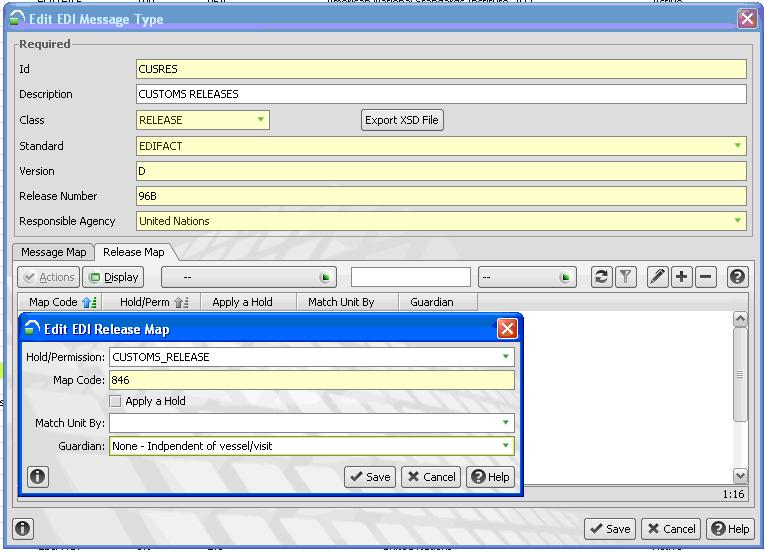
The two fields "Match Unit By" & "Guardian" are used to identify specified container without any ambiguity. As Customs Release is crucial for delivering the container out of the terminal, N4 is intelligent enough to let the user configure the selection criteria. More information about those individual fields is available on product help.
6.1.2 Posting CUSRES EDI
An EDI session should be set up in "EDI Configuration" UI with following values:
Message class: RELEASE
Map: CUSRES_IN (N4 Built in map for CUSRES)
CUSRES EDI can be posted either thro' "EDI Load" UI or scheduled jobs in "EDI Jobs" UI against the EDI session.
6.1.3 Effects of CUSRES EDI in N4:
Once the CUSRES EDI is processed successfully in N4 there are possible consequences to be noted.
N4 grants the particular permission identified by the EDI code in CUSRES thro' Release Map to the given unit.
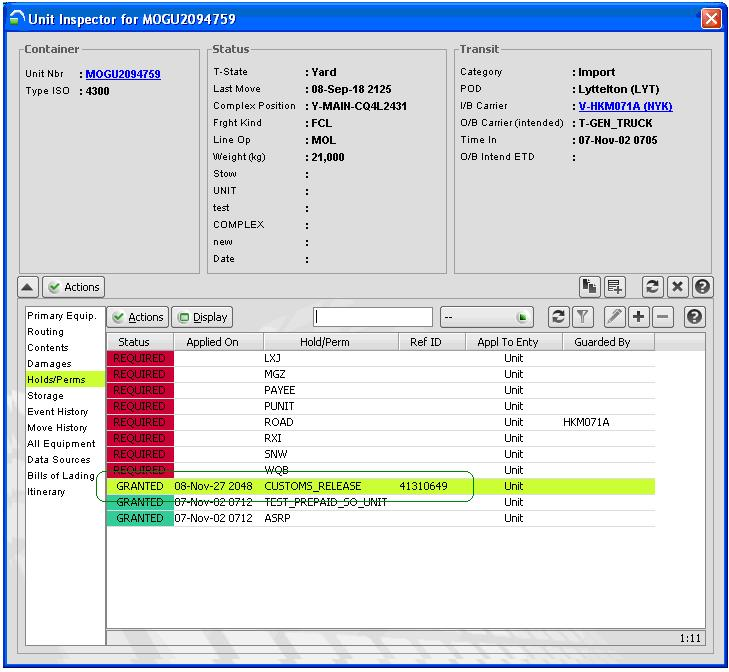
Unit also has the reference id recorded for the particular permission. If EDI has additional codes (refer samples 5.3 & 5.4) N4 applies those permissions as well and can be verified here.
6.1.4 Service Business Rules
CUSRES EDI is just a list of containers that are declared to be released. Once a container has customs release permission granted it can be delivered. But nothing stops a container being delivered without Customs release permission. So to mandate the customs release N4 has a way of defining the rules. This is achieved thro' Service Business Rules (UI Navigation: Configuration -> Services -> Service Business Rules).
For the above case, a Service business rule could be set up as follows:
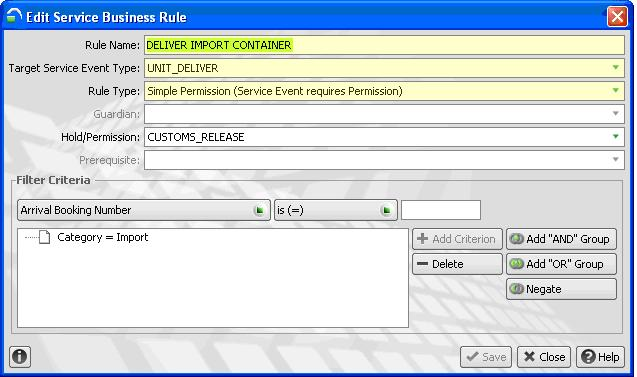
Once this rule is setup no container could be delivered without "CUSTOMS_RELEASE" granted.
6.2.1 Pre-requisite
A permission should be setup thro' Holds/Permissions UI.
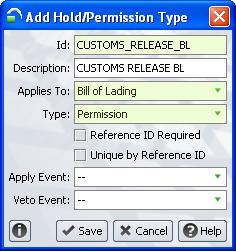
Permission should be configured as to be applicable for Bill of Lading.
In Message Types UI, for CUSRES message, the above permission should be mapped to a respective EDI code that Customs may send in EDI. This is done in "Release Map" tab.

In Settings UI, the "RELEASE_BY_QTY_FLAGTYPE" should be set to the permission id created in step-1.
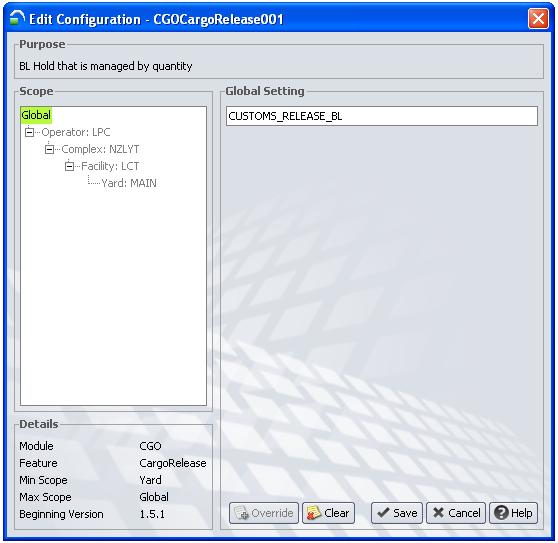
6.2.2 Posting CUSRES EDI
An EDI session should be set up in "EDI Configuration" UI with following values:
Message class: RELEASE
Map: N/A (At present does not provide a Built in map for BL release using CUSRES)
Given this restriction, BL release can be done only in XML. But, a custom map should be created from N4 built-in CUSRES map, it should be able set the following values:
/releaseTransactions/releaseTransaction@releaseIdentifierType should be mapped to constant "BLRELEASE"
/releaseTransactions/releaseTransaction@releaseQty should be set to the number of containers being released against a particular bill of lading at that moment. Customs should send this value in the EDI.
If such Custom map is available then it can be imported into N4 and used in the EDI session.
CUSRES EDI can be posted either thro' "EDI Load" UI or scheduled jobs in "EDI Jobs" UI against the EDI session.
6.2.3 Effects of CUSRES EDI in N4
Once BL release EDI is processed successfully in N4 there are possible consequences to be noted.
N4 adds a BL release record for each BL release message received form Customs & released quantity is also recorded. This can be verified in "BL Releases" sub panel under a particular bill of lading. 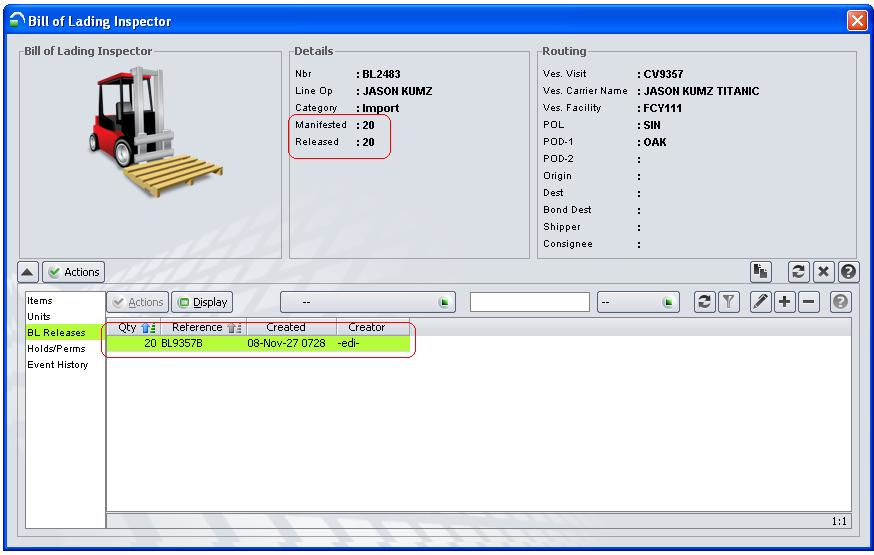
When the total released quantity exceeds the manifested quantity N4 grants release permission for that particular bill of lading, which in turn releases all the containers attached to that BL.
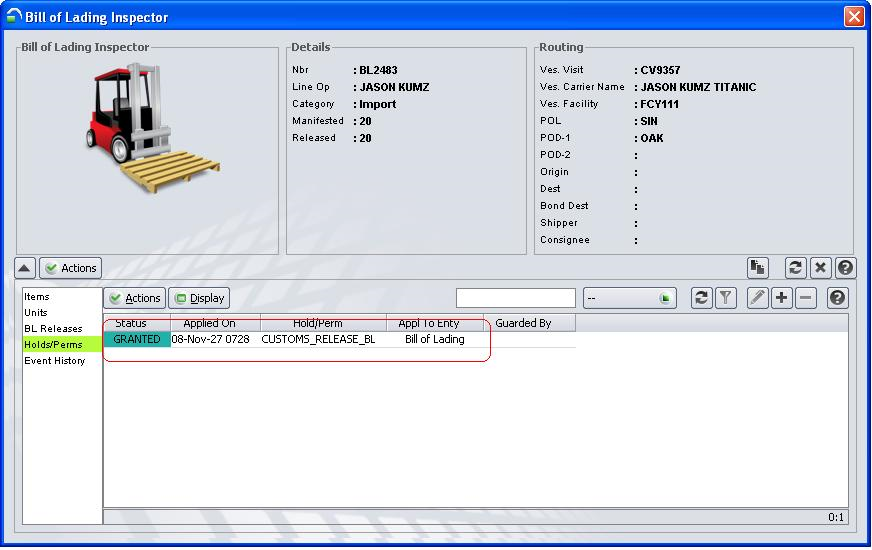
6.2.4 Service Business Rules
When Customs release is practiced as BL release then there is no need of permission at individual container level. So if an Import container has to be delivered then the BL to which the container is attached, should have a valid released permission granted. To mandate such restriction a business rule should be set as shown below in Service Business Rules (UI Navigation: Configuration --> Services --> Service Business Rules).
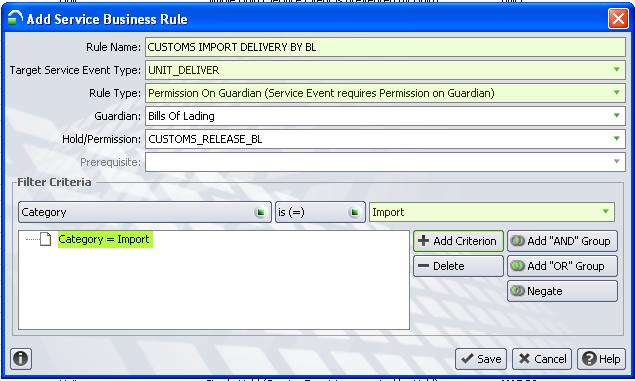
Once this rule is setup no container could be delivered without "CUSTOMS_RELEASE_BL" is granted for the related Bill of Lading.